EYEBROWED THRUSH versus AMERICAN ROBIN
commentary by Don Roberson
One would think that a vagrant Eyebrowed Thrush Turdus obscurus
would not be confused with the familiar American Robin T. migratorius,
but this is a little-known problem not generally treated in the literature
(although briefly considered in Roberson 1980). Occasionally a claim of
an Eyebrowed Thrush has been submitted to the California Bird Records Committee
(4 claims to date, all from Feb-Mar: 25 Feb 1990 Pt. Reyes MRN, 3 Mar 1990
Yaqui Wells SD, 6 Mar 1990 San Rafael MRN, 19 Feb 1995 William Heise Co.
Park SD). All have been rejected, and Pyle and McCaskie (1992) noted that
none were "detailed enough to eliminate an atypical American Robin, particularly
of the western race (T. m. propinquus), which is duller than other
subspecies and often has a distinct superciliary." Yet few folks study
American Robins enough to have seen a bird with a distinct supercilium
(I have not), and the problem deserves some discussion.
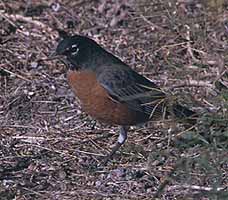
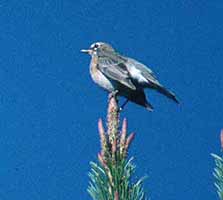 Our "usual" American Robin (leftmost photo) is not much of a problem.
There is a prominent broken eyering (wide white arcs above and below the
eye) but no supercilium; the head and back are quite slaty-gray, and the
throat is whitish, heavily streaked with black. The entire breast, upper
belly, sides & flanks are rusty-red. But in some winters here in Monterey,
California, pale individuals appear (above right) that are very washed-out
below and show much more white on the face, with often a connecting stripe
from the eyering toward the bill, and at least a hint of a supercilium.
I photographed this individual recently because it was about the palest
one I'd ever seen. Since these robins only appear in winter, I have assumed
they are migrants from the north, and were possibly the "Northwestern Robin"
T.
m. caurinus (breeds SE Alaska to coasal Oregon). However, reading Bent
(1949), I find that caurinus is a small dark race, and it is the
propinquus, breeding primarily from the Cascades east in Washington,
that are said to be very pale. Yet these pale birds don't seem to occur
in California populations which are also said to be propinquus.
Our "usual" American Robin (leftmost photo) is not much of a problem.
There is a prominent broken eyering (wide white arcs above and below the
eye) but no supercilium; the head and back are quite slaty-gray, and the
throat is whitish, heavily streaked with black. The entire breast, upper
belly, sides & flanks are rusty-red. But in some winters here in Monterey,
California, pale individuals appear (above right) that are very washed-out
below and show much more white on the face, with often a connecting stripe
from the eyering toward the bill, and at least a hint of a supercilium.
I photographed this individual recently because it was about the palest
one I'd ever seen. Since these robins only appear in winter, I have assumed
they are migrants from the north, and were possibly the "Northwestern Robin"
T.
m. caurinus (breeds SE Alaska to coasal Oregon). However, reading Bent
(1949), I find that caurinus is a small dark race, and it is the
propinquus, breeding primarily from the Cascades east in Washington,
that are said to be very pale. Yet these pale birds don't seem to occur
in California populations which are also said to be propinquus.
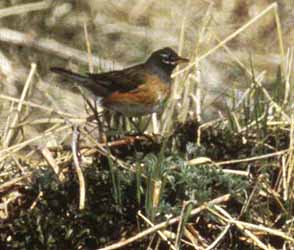 My only experience with Eyebrowed Thrush, a Siberian species, is from Attu
I., Alaska, in June 1980. We saw several birds, and I was struck by how
much they looked like American Robins at a distance. The photo of an
Eyebrowed
Thrush (left) is from Attu I. in May 1982 (© Ed Greaves, used
with permission). The supercilium is hard to see. However, note the lack
of a white throat, the extensively gray neck that extends down to the upper
breast, the brown back contrasting with gray head and, especially, the
extensively pure white belly that extends upwards into the orange breast
as an inverted "V" (this feature emphasized in Roberson 1980). The specimens
below from Museum of Vertebrate Zoology, U.C. Berkeley, a male and a female
Eyebrowed Thrush taken in May in Korea, illustrate these points further:
My only experience with Eyebrowed Thrush, a Siberian species, is from Attu
I., Alaska, in June 1980. We saw several birds, and I was struck by how
much they looked like American Robins at a distance. The photo of an
Eyebrowed
Thrush (left) is from Attu I. in May 1982 (© Ed Greaves, used
with permission). The supercilium is hard to see. However, note the lack
of a white throat, the extensively gray neck that extends down to the upper
breast, the brown back contrasting with gray head and, especially, the
extensively pure white belly that extends upwards into the orange breast
as an inverted "V" (this feature emphasized in Roberson 1980). The specimens
below from Museum of Vertebrate Zoology, U.C. Berkeley, a male and a female
Eyebrowed Thrush taken in May in Korea, illustrate these points further:
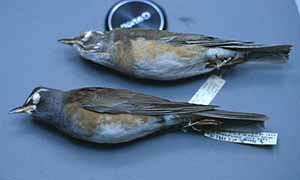
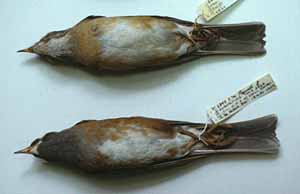 Note that Eyebrowed Thrush has strong sexual dimorphism (the sexes of American
Robins are much less distinctive). Females have broad white throats and
a thin white stripe through the malar region. They do not show the "inverted
V" effect to the belly but have much more white below than do males. On
the male, note the distinct pure white chin, the very extensively gray
throat which extends into the breast, and the white belly with the "V"
pointing up into the rusty lower breast.
Note that Eyebrowed Thrush has strong sexual dimorphism (the sexes of American
Robins are much less distinctive). Females have broad white throats and
a thin white stripe through the malar region. They do not show the "inverted
V" effect to the belly but have much more white below than do males. On
the male, note the distinct pure white chin, the very extensively gray
throat which extends into the breast, and the white belly with the "V"
pointing up into the rusty lower breast.
It would be interesting to post a photo of an American Robin with a
prominent white supercilium on this page, should anyone have such a shot.
Is this phenomenon only found in otherwise pale birds? Is this plumage
restricted to birds from the northwest?
Photos: The "standard" American Robin (upper left) was photographed
4 Nov 1979 at Scottys Castle, Death Valley Nat'l Park, California; the
"pale" American Robin (upper right) was at Ft. Ord, Monterey Co., California,
29 Dec 1994. Ed Greaves took the Eyebrowed Thrush shot on Attu I., Alaska,
in May 1982. The specimens from MVZ are #2842 (male, 18 May, Korea, the
lower bird in each shot) and #3537 (female, 15 May, Korea). I thank Ned
K. Johnson for permission to photograph these specimens back in 1980. All
photos © D. Roberson, except that one attributed © Ed Greaves.
Literature cited:
Bent, A. C. 1949. Life histories of North American thrushes,
kinglets, and their allies. Smithsonian Instit. U.S. Nat. Mus. Bull. 196.
Pyle, P., and G. McCaskie. 1992. Thirteenth report of the California
Bird Records Committee. W. Birds 23: 97-132.
Roberson, D. 1980. Rare Birds of the West Coast. Woodcock Publ., Pacific
Grove, CA.
TOP
BACK TO HOME PAGE
BACK TO LIST OF
BIRD FAMILIES OF THE WORLD
BACK TO BIRDING
THE WORLD PAGE

 Our "usual" American Robin (leftmost photo) is not much of a problem.
There is a prominent broken eyering (wide white arcs above and below the
eye) but no supercilium; the head and back are quite slaty-gray, and the
throat is whitish, heavily streaked with black. The entire breast, upper
belly, sides & flanks are rusty-red. But in some winters here in Monterey,
California, pale individuals appear (above right) that are very washed-out
below and show much more white on the face, with often a connecting stripe
from the eyering toward the bill, and at least a hint of a supercilium.
I photographed this individual recently because it was about the palest
one I'd ever seen. Since these robins only appear in winter, I have assumed
they are migrants from the north, and were possibly the "Northwestern Robin"
T.
m. caurinus (breeds SE Alaska to coasal Oregon). However, reading Bent
(1949), I find that caurinus is a small dark race, and it is the
propinquus, breeding primarily from the Cascades east in Washington,
that are said to be very pale. Yet these pale birds don't seem to occur
in California populations which are also said to be propinquus.
Our "usual" American Robin (leftmost photo) is not much of a problem.
There is a prominent broken eyering (wide white arcs above and below the
eye) but no supercilium; the head and back are quite slaty-gray, and the
throat is whitish, heavily streaked with black. The entire breast, upper
belly, sides & flanks are rusty-red. But in some winters here in Monterey,
California, pale individuals appear (above right) that are very washed-out
below and show much more white on the face, with often a connecting stripe
from the eyering toward the bill, and at least a hint of a supercilium.
I photographed this individual recently because it was about the palest
one I'd ever seen. Since these robins only appear in winter, I have assumed
they are migrants from the north, and were possibly the "Northwestern Robin"
T.
m. caurinus (breeds SE Alaska to coasal Oregon). However, reading Bent
(1949), I find that caurinus is a small dark race, and it is the
propinquus, breeding primarily from the Cascades east in Washington,
that are said to be very pale. Yet these pale birds don't seem to occur
in California populations which are also said to be propinquus.
 My only experience with Eyebrowed Thrush, a Siberian species, is from Attu
I., Alaska, in June 1980. We saw several birds, and I was struck by how
much they looked like American Robins at a distance. The photo of an
Eyebrowed
Thrush (left) is from Attu I. in May 1982 (© Ed Greaves, used
with permission). The supercilium is hard to see. However, note the lack
of a white throat, the extensively gray neck that extends down to the upper
breast, the brown back contrasting with gray head and, especially, the
extensively pure white belly that extends upwards into the orange breast
as an inverted "V" (this feature emphasized in Roberson 1980). The specimens
below from Museum of Vertebrate Zoology, U.C. Berkeley, a male and a female
Eyebrowed Thrush taken in May in Korea, illustrate these points further:
My only experience with Eyebrowed Thrush, a Siberian species, is from Attu
I., Alaska, in June 1980. We saw several birds, and I was struck by how
much they looked like American Robins at a distance. The photo of an
Eyebrowed
Thrush (left) is from Attu I. in May 1982 (© Ed Greaves, used
with permission). The supercilium is hard to see. However, note the lack
of a white throat, the extensively gray neck that extends down to the upper
breast, the brown back contrasting with gray head and, especially, the
extensively pure white belly that extends upwards into the orange breast
as an inverted "V" (this feature emphasized in Roberson 1980). The specimens
below from Museum of Vertebrate Zoology, U.C. Berkeley, a male and a female
Eyebrowed Thrush taken in May in Korea, illustrate these points further:

 Note that Eyebrowed Thrush has strong sexual dimorphism (the sexes of American
Robins are much less distinctive). Females have broad white throats and
a thin white stripe through the malar region. They do not show the "inverted
V" effect to the belly but have much more white below than do males. On
the male, note the distinct pure white chin, the very extensively gray
throat which extends into the breast, and the white belly with the "V"
pointing up into the rusty lower breast.
Note that Eyebrowed Thrush has strong sexual dimorphism (the sexes of American
Robins are much less distinctive). Females have broad white throats and
a thin white stripe through the malar region. They do not show the "inverted
V" effect to the belly but have much more white below than do males. On
the male, note the distinct pure white chin, the very extensively gray
throat which extends into the breast, and the white belly with the "V"
pointing up into the rusty lower breast.